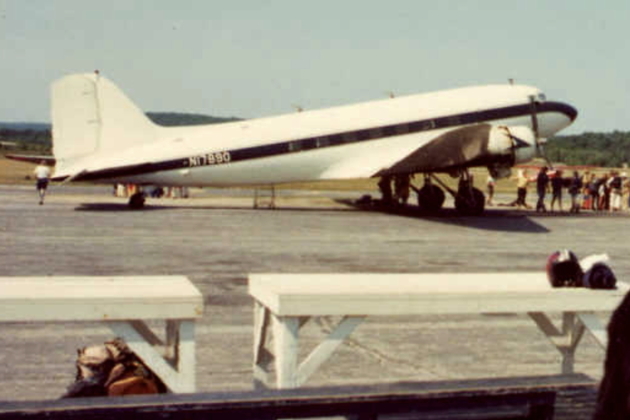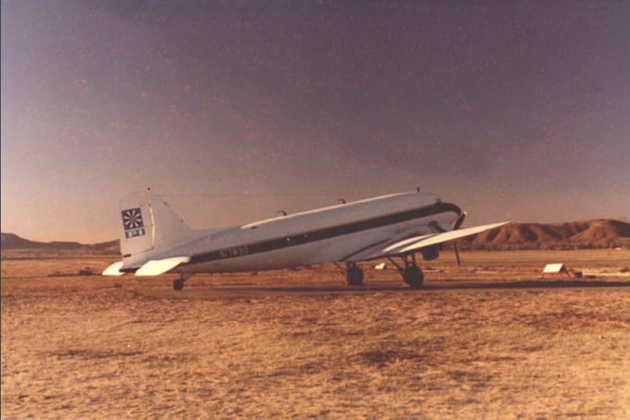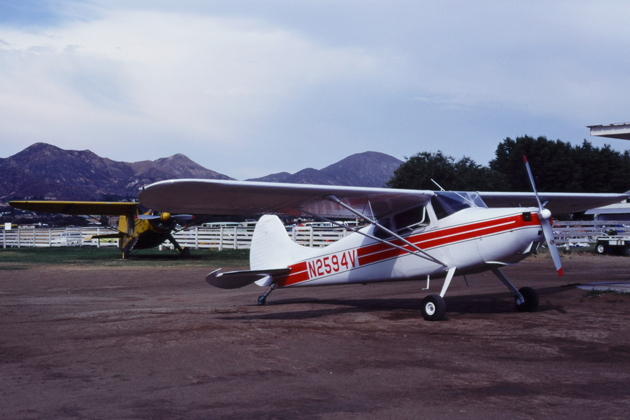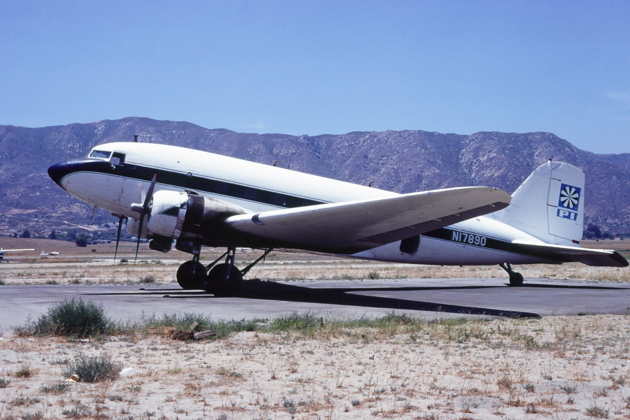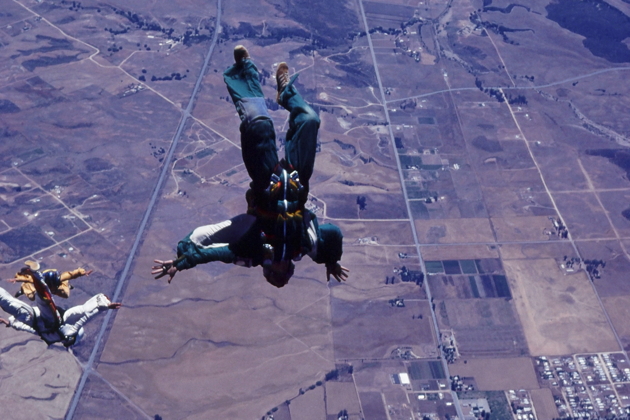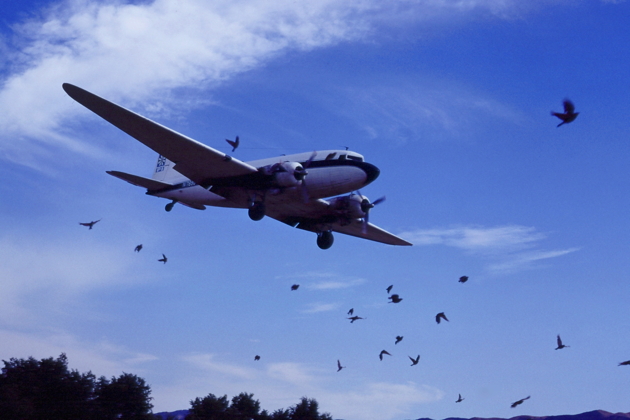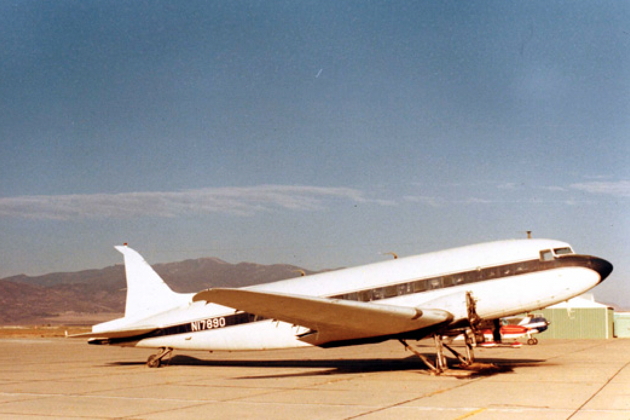FlightLog Archive
∟Aircraft Flown
Flying the DC-3 - Jul 1977
In July 1977 I was a student in the middle of USAF pilot training at Williams AFB, AZ. I had just finished flying the T-37 for five months, and I was early in the T-38 phase. Greg Trebon, who was a class behind me in pilot training, owned a Cessna 170 that he was keeping at nearby Falcon Field in Mesa, AZ. Before entering USAF pilot training, Greg was a jump ship pilot flying the classic DC-3 in California.
Greg and I were neighbors on base at Williams AFB, had become friends through our temporary jobs while waiting for the start of pilot training, and continually discussed flying opportunities whenever we had the chance. When I learned of Greg's plans for a quick weekend California flying trip, I happily joined his excursion when invited. Greg and I took off from Falcon Field at 6:15 AM on Saturday, 16 July in his Cessna 170. We cruised through the Arizona desert westbound, past Palm Springs and descended down to the airport at Elsinore, CA.
Once Greg Trebon and I landed at Elsinore, he was quickly marshaled into service again as a jump ship pilot, and I was able to accompany him for two flights in a classic DC-3. I was also very lucky to get 30 minutes of 'hands-on' flying in this stately aircraft.
N17890 was the serial number of this DC-3, and I was able to find some amazing history on this proud bird. It was originally delivered as a C-53-DO on 27 Sep 1942, with USAAF serial number 42-15568. Known as a C-53 Skytrooper, the troop transport version of the C-47, this '-D' model is a modification of the C-53C with a 24V DC electrical system. Only 159 C-53Ds were built. After VE Day she was sold to United Airlines on 14 June 1945, and flew with United until August 1949, re-registered as Douglas DC-3A-S1C3G C/N 7363.
Dixon Gourley from Sedona, AZ has some historical notes on this DC-3: "I flew N17890 as a corporate pilot for the Symington Wayne Corporation in the mid 60's and logged about 1,200 hours over the course of several years. The ship was previously named, 'Little Sir Echo' by United Airlines who used it as a test bed for airborne radar development. It had the speed conversion kit; wheel door fairings and the 1830-94 P+W, M-2 version with the blowers. The interior was 'Exec' configuration." After -890 left the United stable and Symington Wayne Corporation, it was found by Jasque Istel in Texas and moved to Orange, CA, then to Elsinore with its parachuting operation.
On our first DC-3 flight in mid-afternoon, I flew in the jump seat as an observer, and got some great views and photos of the jumpers exiting the large open cabin door. Greg did a great job maneuvering the DC-3 on approach in some bumpy thermals.
On the second flight, we timed our takeoff to make a sunset parachute drop, and Greg allowed me to have 30 minutes of right seat time. I was able to fly the climb out and maneuver the DC-3 into the racetrack pattern used to position for the jump runs. The first thing I noticed was the roll rate. I had just spent the last two weeks getting familiar with the T-38's roll rate, at a theoretical maximum of 720 degrees per second. The slow, ponderous roll characteristics of the DC-3 felt like 720 degrees per week, in comparison. However, as I got more familiar, she felt like a very stable airplane that just needed her own coaxing into a maneuver.
The view and experience from the right seat, with the sun setting over the Pacific, as we cruised around the jump pattern and made small adjustments to line up correctly on the jump line, was almost surreal. With the sounds and smells and deep vibration through the control column and rudder pedals, I felt like I began to understand some of the mystique of this proud old bird, and a small kinship with legions of DC-3/C-47 pilots.
I was also able to get a full immersion into DC-3 culture by spending the night in a sleeping bag in the DC-3. I bed down in the main cabin up near the cockpit at about 12:30 AM, and woke up in the morning down by the tail. The DC-3 cabin definitely slopes when on the ground!
I was able to get a local soaring flight at mid-day, and then Greg and I flew back to Arizona, dodging a huge thunderstorm by diverting south around Gila Bend, AZ.
N17890 continued as a jump ship for many years, and was spotted in 1985 in San Diego with only its fuselage intact. N17890 was sadly scrapped, and finally de-registered on 2 March 1990. I'm very proud to have had the opportunity to fly her, if only for a short while, and experience the wonder of the DC-3.
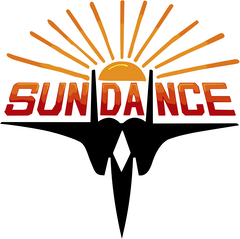 KASPRZYK
KASPRZYK